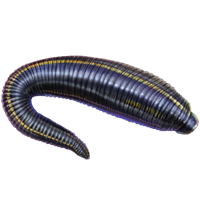Started Culturing Leech, Pets for Health Therapies
During this time, leeches mostly viewed as a disgusting animal. However if you are keen to see an opportunity, then leeches could actually be a promising business opportunity. Cultivation leeches are particularly advantageous because now this trend is happening is that people are trying again using traditional therapy for health, and one of them is with the leech therapy.
Preparation of the cage to start cultivating leech
For those of you who want to start cultivation of these leeches, the first thing is to be prepared the pond. For the cage, you can prepare the following:
1. Pool of the wall, with a height of about 30 cm, and freely according to the size of land you have.
2. Give the mud, sand, rocks, or other things that normally exist in the native habitat of leeches that could leech attached.
3. Cover the pool with gauze so that the leeches are not blurred.
4. Keep the water temperature is 18-20o for children leeches, and 25-30o to raise leeches.
Conditions that can leech life
Leeches must be distinguished from the slug that might ever meet clinging to trees or leaves. When slugs like dry place, then the leech is an animal whose life requires water. Therefore, good water quality is required. To get a leech with the best conditions, the condition of the water in which they live must be:
1. Having acidic conditions or pH between 5 and 7.
2. Have a humidity of 30% to 40%.
3. Make an leech differ for children and adult leeches, leech because the parent can take the child.
4. Remember, the right temperature for leech child is 18-20 degrees and 25-30 degrees enlargement, so create different pools for enlargement and breed.
So that the leeches can develop well
Because leeches are hermaphroditic animals, you simply put the seeds leeches in the pond that had been prepared, and they will breed itself. Choose the parent leech 6 months old for breeding because they are ready to breed. If you want all goes well, then give the parent leeches eat once in two weeks time. Feed for leeches themselves easy to find, such as catfish, eel or other fish that have smooth skin and eases the leech to be attached to the surface of their skin and eat.
Marketing sells leeches
Leeches declared ready for the market when it was 4-6 months old. When you buy 50 leeches as seeds in the beginning, you will get about 20,000 leeches at the end of the breeding. Animals are used for medical therapy, then the best way to market is certainly with:
1. Contact the leech collectors who will buy leeches results of your efforts to be distributed to companies that need.
2. Sell to the pharmacy, where the manufacture of pharmaceuticals.
3. Sale to the seller of traditional medicine.
4. Self closing venture leech therapy in your place.
During this time, leeches mostly viewed as a disgusting animal. However if you are keen to see an opportunity, then leeches could actually be a promising business opportunity. Cultivation leeches are particularly advantageous because now this trend is happening is that people are trying again using traditional therapy for health, and one of them is with the leech therapy.
Preparation of the cage to start cultivating leech
For those of you who want to start cultivation of these leeches, the first thing is to be prepared the pond. For the cage, you can prepare the following:
1. Pool of the wall, with a height of about 30 cm, and freely according to the size of land you have.
2. Give the mud, sand, rocks, or other things that normally exist in the native habitat of leeches that could leech attached.
3. Cover the pool with gauze so that the leeches are not blurred.
4. Keep the water temperature is 18-20o for children leeches, and 25-30o to raise leeches.
Conditions that can leech life
Leeches must be distinguished from the slug that might ever meet clinging to trees or leaves. When slugs like dry place, then the leech is an animal whose life requires water. Therefore, good water quality is required. To get a leech with the best conditions, the condition of the water in which they live must be:
1. Having acidic conditions or pH between 5 and 7.
2. Have a humidity of 30% to 40%.
3. Make an leech differ for children and adult leeches, leech because the parent can take the child.
4. Remember, the right temperature for leech child is 18-20 degrees and 25-30 degrees enlargement, so create different pools for enlargement and breed.
So that the leeches can develop well
Because leeches are hermaphroditic animals, you simply put the seeds leeches in the pond that had been prepared, and they will breed itself. Choose the parent leech 6 months old for breeding because they are ready to breed. If you want all goes well, then give the parent leeches eat once in two weeks time. Feed for leeches themselves easy to find, such as catfish, eel or other fish that have smooth skin and eases the leech to be attached to the surface of their skin and eat.
Marketing sells leeches
Leeches declared ready for the market when it was 4-6 months old. When you buy 50 leeches as seeds in the beginning, you will get about 20,000 leeches at the end of the breeding. Animals are used for medical therapy, then the best way to market is certainly with:
1. Contact the leech collectors who will buy leeches results of your efforts to be distributed to companies that need.
2. Sell to the pharmacy, where the manufacture of pharmaceuticals.
3. Sale to the seller of traditional medicine.
4. Self closing venture leech therapy in your place.
Posted Medicinal Leech Therapy Read More







